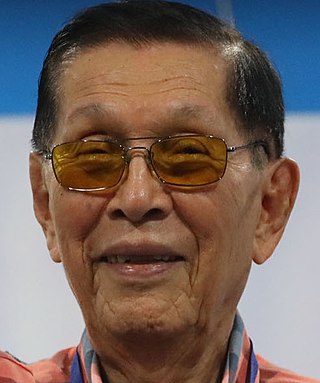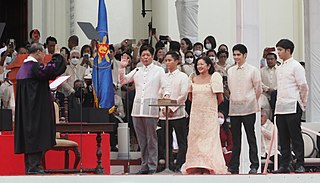
Maria Corazon "Cory" Sumulong Cojuangco-Aquino was a Filipino politician who served as the eleventh president of the Philippines from 1986 to 1992. She was the most prominent figure of the 1986 People Power Revolution, which ended the two-decade rule of President Ferdinand Marcos and led to the establishment of the current democratic Fifth Philippine Republic.

Malacañang Palace, officially known as Malacañan Palace, is the official residence and principal workplace of the president of the Philippines. It is located in the Manila district of San Miguel, along Jose P. Laurel Street though it is commonly associated with Mendiola Street nearby. The term Malacañang is often used as a metonym for the president, their advisers, and the Office of the President of the Philippines. The sprawling Malacañang Palace complex includes numerous mansions and office buildings designed and built largely in the bahay na bato and neoclassical styles. Among the presidents of the present Fifth Republic, only Gloria Macapagal Arroyo actually lived in the main palace as both her office and her residence, with all others residing in nearby properties that form part of the larger palace complex. The palace has been seized several times as a result of protests starting with the People Power Revolution of 1986, the 1989 coup attempt, the 2001 Manila riots, and the EDSA III riots.

The People Power Revolution, also known as the EDSA Revolution or the February Revolution, was a series of popular demonstrations in the Philippines, mostly in Metro Manila, from February 22 to 25, 1986. There was a sustained campaign of civil resistance against regime violence and electoral fraud. The nonviolent revolution led to the departure of Ferdinand Marcos, the end of his 20-year dictatorship and the restoration of democracy in the Philippines.

San Juan, officially the City of San Juan, is a 1st class highly urbanized city in the National Capital Region of the Philippines. According to the 2020 census, it has a population of 126,347 people. It is geographically located at Metro Manila's approximate center and is also the country's smallest city in terms of land area.
Renato "Rene" Salud de Villa is a Filipino former police and military officer and government official. He served as Chief of Philippine Constabulary, Director-General of the Integrated National Police, and Chief of Staff of the Armed Forces of the Philippines. He then served as Secretary of National Defense under presidents Corazon Aquino and Fidel V. Ramos. He founded Partido para sa Demokratikong Reporma for his unsuccessful presidential bid in 1998. He then briefly served as Executive Secretary under President Gloria Macapagal Arroyo.

Juan Valentin Furagganan Ponce Enrile Sr.,, also referred to by his initials JPE, is a Filipino politician and lawyer known for his role in the administration of Philippine president Ferdinand Marcos; his role in the failed coup that helped hasten the 1986 People Power Revolution and the ouster of Marcos; and his tenure in the Philippine legislature in the years after the revolution. Enrile has served four terms in the Senate, in a total of twenty-two years, he holds the third longest-tenure in the history of the upper chamber. In 2022, at the age of 98, he returned to government office as the Chief Presidential Legal Counsel in the administration of President Bongbong Marcos.
Herminio Sanchez Aquino, also known as Hermie Aquino, was a Filipino businessman, politician, and a vice presidential candidate who ran as the running mate of Raul Roco in 2004.

The 1992 Philippine presidential and vice presidential elections were held on May 11, 1992. This was the first general election held under the 1987 Constitution. An estimated 80,000 candidates ran for 17,000 posts from the presidency down to municipal councilors.

The Four Day Revolution is a 1988 Australian television film directed by Robert Markowitz and written by David Williamson. The story is about the journey and the love affair of an American foreign correspondent set during the final years of Ferdinand Marcos' dictatorship in the Philippines, from the assassination of Benigno Aquino Jr. in 1983 to the People Power Revolution in 1986, as well as other key events that led to the ouster of Marcos.

The Manila Hotel is a 550-room, historic five-star hotel located along Manila Bay in Manila, Philippines. The hotel is the oldest premiere hotel in the Philippines built in 1909 to rival Malacañang Palace, the official residence of the President of the Philippines and was opened on the commemoration of American Independence on July 4, 1912. The hotel complex was built on a reclaimed area of 35,000 square metres (380,000 sq ft) at the northwestern end of Rizal Park along Bonifacio Drive in Ermita. Its penthouse served as the residence of General Douglas MacArthur during his tenure as the Military Advisor of the Philippine Commonwealth from 1935 to 1941.

The inauguration of the president of the Republic of the Philippines is a ceremony marking the commencement of the six-year term of a president of the Philippines, who is both head of state and head of government. The inauguration is performed on June 30, as mandated by the 1987 Constitution. Under the older 1935 Constitution, the date was December 30, which is also Rizal Day; the last inauguration held on the older date was Ferdinand Marcos' second one on December 30, 1969. The most recent public presidential inauguration ceremony was that of President Bongbong Marcos, who began his six-year term in office on Thursday, June 30, 2022.

The presidential transition of Benigno Aquino III began when he won the 2010 Philippine presidential election. On June 9, 2010, at the Batasang Pambansa Complex, in Quezon City, the Congress of the Philippines proclaimed Aquino as the president-elect of the Philippines, following the 2010 election with 15,208,678 votes, while Jejomar Binay, the former mayor of Makati, was proclaimed as the vice president-elect of the Philippines with 14,645,574 votes, defeating runner-up for the vice presidency Mar Roxas, the standard-bearer of the Liberal Party for vice president.
The 2010 presidential campaign of Benigno Aquino III, then Philippine Senator, began when he announced his candidacy for the presidency of the Philippines at the Club Filipino, Greenhills, San Juan, Metro Manila, on September 9, 2009, 40 days after the death of his mother, former President Corazon Aquino. On September 21, 2009, Aquino's campaign announced that Senator Mar Roxas would be his vice presidential nominee.

Teofisto "Tito" Tayko Guingona Jr. is a Filipino politician and diplomat who served as the 11th Vice President of the Philippines from 2001 to 2004, during the first term of President Gloria Macapagal Arroyo. Born in San Juan, Rizal, Teofisto is a graduate of Ateneo de Manila University, where he was a working student.

The fourth inauguration of Ferdinand Marcos as the tenth president of the Philippines took place on Tuesday, February 25, 1986, at Malacañang Palace in Manila. The inauguration marked the commencement of the fourth term of Ferdinand Marcos as president. Marcos eventually stepped down as president a few hours later while the 3-day mass demonstrations were taking place.
1986 in the Philippines details events of note that happened in the Philippines in the year 1986.
The People Power Revolution was a series of popular demonstrations in the Philippines that began in 1983 and culminated in 1986. The methods used amounted to a sustained campaign of civil resistance against regime violence and electoral fraud. This case of nonviolent revolution led to the toppling of dictator Ferdinand Marcos and the restoration of the country's democracy.
Emanuel Maurice "Emil" Bachrach was a born Russian Jewish and became an American entrepreneur and philanthropist in the Philippines.

The Presidential Car Museum is a museum within the Quezon Memorial Circle in Quezon City, Metro Manila, Philippines. The museum displays cars used by the former Philippine Presidents.

Napoleon "Nap" Genson Rama, PLH was a Filipino Visayan lawyer, journalist, and writer in English and Spanish from Cebu, Philippines. He was the Vice President of the 1971 Constitutional Convention and the Floor Leader of the 1986 Constitutional Commission. In 2011, he was awarded the Philippine Legion of Honor, the country's highest recognition, with the rank of Grand Commander on the 25th anniversary of the EDSA 1 Revolution by President Benigno S. Aquino III.














